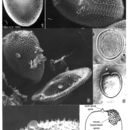Ecology
(
anglais
)
fourni par NMNH Marine Dinoflagellates
P. minimum is a bloom-forming planktonic species. Cosmopolitan in temperate, brackish waters to tropical regions; mostly estuarine, but also neritic (Steidinger & Tangen 1996; Faust et al. 1999). Due to its small size, this species is probably often lost or overlooked in field samples (Dodge, 1982). Cells are active swimmers (Parke & Ballantine 1957). Recently, Stoecker et al. (1997) reported mixotrophy in this species; ingested cryptophytes were observed in cells of P. minimum.
- citation bibliographique
- Faust, Maria A. and Rose A. Gulledge. Identifying Harmful Marine Dinoflagellates. Smithsonian Contributions from the United States National Herbarium, volume 42: 1-144 (including 48 plates, 1 figure and 1 table).
Habitat and Locality
(
anglais
)
fourni par NMNH Marine Dinoflagellates
P. minimum is commonly found along the west coast of the USA, Japan, Gulf of Mexico, Caspian, Adriatic, Mediterranean and Black Seas, and Scandinavian waters; often in large numbers (Dodge 1982; Tangen 1980; 1983; Marasovic et al. 1990).
- citation bibliographique
- Faust, Maria A. and Rose A. Gulledge. Identifying Harmful Marine Dinoflagellates. Smithsonian Contributions from the United States National Herbarium, volume 42: 1-144 (including 48 plates, 1 figure and 1 table).
Morphology and Structure
(
anglais
)
fourni par NMNH Marine Dinoflagellates
P. minimum is a photosynthetic species has golden-brown chloroplasts, one large pyrenoid and two pusules. The nucleus is broadly ellipsoidal and posteriorly situated (Parke & Ballantine 1957; Faust 1974; Dodge 1982).
- citation bibliographique
- Faust, Maria A. and Rose A. Gulledge. Identifying Harmful Marine Dinoflagellates. Smithsonian Contributions from the United States National Herbarium, volume 42: 1-144 (including 48 plates, 1 figure and 1 table).
Nomenclatural Types
(
anglais
)
fourni par NMNH Marine Dinoflagellates
Holotype: Exuviaella minima Schiller, 1933: figs. 33a,
Type Locality: Mediterranean Sea: Gulf of Lion, France
- citation bibliographique
- Faust, Maria A. and Rose A. Gulledge. Identifying Harmful Marine Dinoflagellates. Smithsonian Contributions from the United States National Herbarium, volume 42: 1-144 (including 48 plates, 1 figure and 1 table).
Reproduction
(
anglais
)
fourni par NMNH Marine Dinoflagellates
P. minimum reproduces asexually by binary fission.
- citation bibliographique
- Faust, Maria A. and Rose A. Gulledge. Identifying Harmful Marine Dinoflagellates. Smithsonian Contributions from the United States National Herbarium, volume 42: 1-144 (including 48 plates, 1 figure and 1 table).
Species Comparisons
(
anglais
)
fourni par NMNH Marine Dinoflagellates
P. minimum can be confused with P. balticum; however, the former species differs by its larger size and different shape, and by having only one apical spine and a forked periflagellar collar (Faust et al. 1999).
- citation bibliographique
- Faust, Maria A. and Rose A. Gulledge. Identifying Harmful Marine Dinoflagellates. Smithsonian Contributions from the United States National Herbarium, volume 42: 1-144 (including 48 plates, 1 figure and 1 table).
Species Overview
(
anglais
)
fourni par NMNH Marine Dinoflagellates
P. minimum is an armoured, marine, planktonic, bloom-forming dinoflagellate. It is a toxic cosmopolitan species common in cold temperate brackish waters to tropical regions.
- citation bibliographique
- Faust, Maria A. and Rose A. Gulledge. Identifying Harmful Marine Dinoflagellates. Smithsonian Contributions from the United States National Herbarium, volume 42: 1-144 (including 48 plates, 1 figure and 1 table).
Synonyms
(
anglais
)
fourni par NMNH Marine Dinoflagellates
Exuviaella minima Pavillard, 1916
Prorocentrum triangulatum Martin, 1929
Exuviaella marie-lebouriae Parke and Ballantine, 1957
Prorocentrum cordiformis Bursa, 1959
Prorocentrum mariae-lebouriae (Parke and Ballantine, 1957) Loeblich III, 1970
- citation bibliographique
- Faust, Maria A. and Rose A. Gulledge. Identifying Harmful Marine Dinoflagellates. Smithsonian Contributions from the United States National Herbarium, volume 42: 1-144 (including 48 plates, 1 figure and 1 table).
Taxonomic Description
(
anglais
)
fourni par NMNH Marine Dinoflagellates
P. minimum is a bivalvate species often observed in valve view. Cells are small (14-22 µm long to 10-15 µm wide) and shape is variable: cells range from triangular (Fig. 1), to oval (Figs. 3, 5, 7), to heart-shaped (Fig. 6). Cells are laterally flattened (Fig. 3). A short apical spine is sometimes observable (Figs. 1-4, 7). Valves with short, evenly shaped broad-based spines (about 600-700 per valve) arranged in a regular pattern (Figs. 1-4). These can appear as rounded papillae depending on angle of view. There are two sized pores present: smaller pores are scattered (Figs. 1, 4), while larger pores are located at the base of some peripheral spines. The intercalary band is transversely striated (Figs. 2, 5, 6) (Parke & Ballantine 1957; Faust 1974; Dodge 1982; Steidinger & Tangen 1996). The broad anterior end is truncate with a relatively small, shallow, broadly V-shaped depressed periflagellar area located apically on the right valve, slightly off-center (Figs. 1-7). The periflagellar area bears eight apical platelets and two pores of unequal size: a large flagellar pore and a smaller auxiliary pore (Fig. 2). Adjacent to the flagellar pore is a small apical spine (Figs. 2, 7). Adjacent to the auxiliary pore is a small, curved and forked periflagellar collar (Figs. 1, 2) (Parke & Ballantine 1957; Dodge & Bibby 1973; Faust 1974).
- citation bibliographique
- Faust, Maria A. and Rose A. Gulledge. Identifying Harmful Marine Dinoflagellates. Smithsonian Contributions from the United States National Herbarium, volume 42: 1-144 (including 48 plates, 1 figure and 1 table).
Toxicity
(
anglais
)
fourni par NMNH Marine Dinoflagellates
P. minimum is a toxic species; it produces venerupin (hepatotoxin) which has caused shellfish poisoning resulting in gastrointestinal illnesses in humans and a number of deaths. This species is also responsible for shellfish kills in Japan and the Gulf of Mexico, Florida (Nakazima 1965; Nakazima 1968; Smith 1975; Okaichi & Imatomi 1979; Tangen 1983; Shimizu 1987; Steidinger & Tangen 1996).
- citation bibliographique
- Faust, Maria A. and Rose A. Gulledge. Identifying Harmful Marine Dinoflagellates. Smithsonian Contributions from the United States National Herbarium, volume 42: 1-144 (including 48 plates, 1 figure and 1 table).

